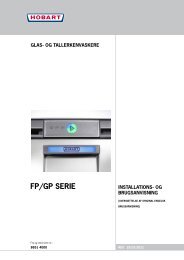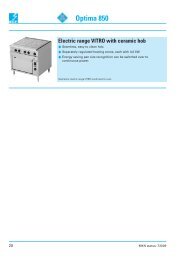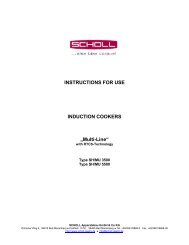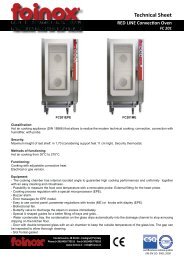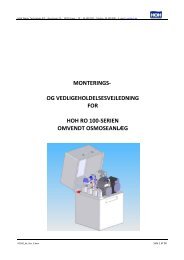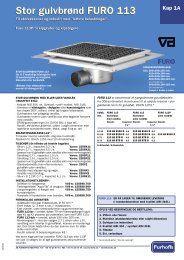Deep fat fryer (electric) - Bent Brandt WebShop
Deep fat fryer (electric) - Bent Brandt WebShop
Deep fat fryer (electric) - Bent Brandt WebShop
You also want an ePaper? Increase the reach of your titles
YUMPU automatically turns print PDFs into web optimized ePapers that Google loves.
Translation of the original operating instructions 2020321-03ABDE-C / 05.04.2011 / TAG-MaBr<br />
Operating manual<br />
<strong>Deep</strong> <strong>fat</strong> <strong>fryer</strong> (<strong>electric</strong>)<br />
Version<br />
London I<br />
London II<br />
Paris<br />
2020321-03ABBE-C / en-GB<br />
Open out the cover page to see the<br />
controls.<br />
Operating manual
<strong>Deep</strong> <strong>fat</strong> <strong>fryer</strong> (<strong>electric</strong>)<br />
Controls<br />
Figure 1: Standard version<br />
1 Unit switch<br />
3<br />
2 “Heating mode” control lamp<br />
3 Temperature regulator<br />
4 Safety temperature limiter<br />
(not with marine versions)<br />
5 2. Safety temperature limiter (optional)<br />
OIL-LEVEL<br />
11<br />
10<br />
OVERTEMP-1<br />
OVERTEMP-2<br />
Figure 2: Optional equipment<br />
6 Timer<br />
9<br />
2<br />
5<br />
OIL PUMP<br />
8<br />
3<br />
7<br />
2<br />
4<br />
RESET<br />
(units with frying basket lifting mechanism)<br />
7 “Reset” button<br />
8 Switch for <strong>fat</strong> filter system<br />
9 “Over-temperature 2” control lamp<br />
(units with FSC)<br />
10 “Over-temperature 1” control lamp<br />
(units with 2 safety temperature limiters and FSC)<br />
11 “Filling level” control lamp<br />
(units with FSC)<br />
Operating manual<br />
6<br />
1<br />
Operating manual<br />
<strong>Deep</strong> <strong>fat</strong> <strong>fryer</strong> (<strong>electric</strong>)
<strong>Deep</strong> <strong>fat</strong> <strong>fryer</strong> (<strong>electric</strong>)<br />
1<br />
1.1<br />
1.2<br />
1.3<br />
1.4<br />
1.5<br />
2<br />
3<br />
3.1<br />
3.1.1<br />
3.1.2<br />
3.1.3<br />
3.2<br />
3.3<br />
3.4<br />
3.5<br />
3.6<br />
4<br />
4.1<br />
4.2<br />
4.3<br />
4.3.1<br />
4.3.2<br />
4.4<br />
4.4.1<br />
4.4.2<br />
4.5<br />
4.6<br />
4.7<br />
4.8<br />
4.8.1<br />
4.8.2<br />
5<br />
5.1<br />
Introduction ...........................................................<br />
Intended use ......................................................................<br />
About this operating manual ...........................................<br />
Warnings ............................................................................<br />
Warranty and liability ........................................................<br />
Signs and symbols ...........................................................<br />
Safety information ................................................<br />
Construction and function ...................................<br />
Description of the unit ......................................................<br />
Version London I .........................................................................<br />
Version London II ........................................................................<br />
Version Paris ...............................................................................<br />
Features .............................................................................<br />
Description of the controls ..............................................<br />
Using frying <strong>fat</strong> and oil .....................................................<br />
Recommended frying temperatures and times ..............<br />
Filling quantities ...............................................................<br />
Operation ...............................................................<br />
Commissioning .................................................................<br />
Filling with frying <strong>fat</strong> .........................................................<br />
Switching on/switching off unit .......................................<br />
Switching on ...............................................................................<br />
Switching off ...............................................................................<br />
Basic functions .................................................................<br />
Setting the temperature ..............................................................<br />
Setting the time ...........................................................................<br />
<strong>Deep</strong> frying ........................................................................<br />
Frying (with the frying basket lifting mechanism) .........<br />
End of operation and breaks ...........................................<br />
Emptying the unit ..............................................................<br />
Draining off the frying <strong>fat</strong> .............................................................<br />
Filtering frying <strong>fat</strong> with the integrated <strong>fat</strong> filtering system ............<br />
Cleaning ................................................................<br />
Avoiding corrosion ...........................................................<br />
Operating manual<br />
Contents<br />
5<br />
5<br />
5<br />
6<br />
6<br />
7<br />
8<br />
10<br />
10<br />
10<br />
11<br />
12<br />
12<br />
13<br />
14<br />
14<br />
15<br />
16<br />
16<br />
16<br />
16<br />
16<br />
17<br />
17<br />
17<br />
18<br />
18<br />
19<br />
20<br />
21<br />
21<br />
21<br />
23<br />
23<br />
3
Contents<br />
4<br />
5.2<br />
5.3<br />
5.4<br />
5.5<br />
6<br />
6.1<br />
6.2<br />
6.2.1<br />
6.2.2<br />
6.3<br />
6.4<br />
7<br />
7.1<br />
8<br />
General cleaning ...............................................................<br />
Cleaning the housing .......................................................<br />
Cleaning the frying basin .................................................<br />
Cleaning the tubular heating elements ...........................<br />
Faults .....................................................................<br />
Correcting faults ...............................................................<br />
Safety temperature limiter (STL) triggered .....................<br />
Switching the STL back on after exceeding the maximum<br />
operating temperature ................................................................<br />
Switching the STL back on if the ambient temperature falls below<br />
0 °C .............................................................................................<br />
Control lamp is defective .................................................<br />
Cause of errors and troubleshooting ..............................<br />
Service ...................................................................<br />
Disposal .............................................................................<br />
Declarations of Conformity ..................................<br />
Operating manual<br />
<strong>Deep</strong> <strong>fat</strong> <strong>fryer</strong> (<strong>electric</strong>)<br />
23<br />
24<br />
24<br />
25<br />
26<br />
26<br />
26<br />
26<br />
27<br />
27<br />
28<br />
29<br />
29<br />
30
<strong>Deep</strong> <strong>fat</strong> <strong>fryer</strong> (<strong>electric</strong>)<br />
1 Introduction<br />
1.1 Intended use<br />
MKN deep <strong>fat</strong> <strong>fryer</strong>s are appliances solely intended to be used for<br />
commercial purposes, especially in commercial kitchens.<br />
The unit may only be used with suitable frying <strong>fat</strong>s for the purpose of deep<br />
frying food.<br />
It is not permitted to use the unit for the following purposes, among others:<br />
● Drying towels, paper or dishes<br />
● Heating acids, brines or other chemicals<br />
● Heating inflammable liquids<br />
● Melting <strong>fat</strong>s or salts<br />
● As a food warmer<br />
● Cooking noodles, potatoes, vegetables or other food in salt water<br />
● Cooking soups or sauces<br />
● Defrosting frozen foods<br />
1.2 About this operating manual<br />
This operating manual is part of the equipment and contains information<br />
required by the persons operating the unit to enable them to operate it<br />
safely, for cleaning and looking after the unit and for handling faults.<br />
● The employees engaged to perform any tasks with the unit must have<br />
read the operating manual, especially the section “Safety information”,<br />
before beginning work.<br />
● Keep this operating manual stored safely during the life of the unit.<br />
● Make sure that this operating manual is constantly available for the<br />
staff at the place where the unit is used.<br />
● Supply this operating manual to any subsequent owner or user of the<br />
unit.<br />
● Include any supplements received from the manufacturer.<br />
● Supplement the instructions, including supervisory or notification<br />
requirements, to take account of special operational circumstances<br />
e.g. work organisation, workflows or deployed staff.<br />
Target group ● This operating manual is intended for employees who are responsible<br />
for operating, cleaning and looking after the unit as well as handling<br />
faults.<br />
● Repairs to the unit may only be carried out by specially trained<br />
technical staff.<br />
Operating manual<br />
Introduction<br />
5
Introduction<br />
6<br />
● Adults may not use the unit without supervision if<br />
- they are unable to do so due to their physical, sensory or mental<br />
capabilities,<br />
- they do not have the knowledge and experience required to<br />
operate the unit safely and in the manner intended.<br />
1.3 Warnings<br />
Warnings are indicated with a pictogram and a signal word.<br />
The type and source of the risk as well as the consequences are described<br />
together with instructions for avoiding the danger. The meanings of the<br />
pictograms and signal words used are explained in section “Signs and<br />
symbols” (see Chapter “Signs and symbols”, Page 7).<br />
1.4 Warranty and liability<br />
The unit may not be modified or technically changed.<br />
All guarantees or warranties cease to exist if technical changes are made.<br />
Furthermore, the safety of the unit is no longer guaranteed.<br />
Claims for warranty or liability for damages to persons or property are<br />
excluded if they arise from one or more of the following causes:<br />
● Improper use of the unit<br />
● Incorrect installation, commissioning, operation or servicing of the<br />
unit<br />
● Technical changes to the unit without the binding agreement of the<br />
manufacturer<br />
● Use of spare parts or accessories not approved by MKN<br />
● Faults resulting from the failure to comply with these operating<br />
instructions<br />
Operating manual<br />
<strong>Deep</strong> <strong>fat</strong> <strong>fryer</strong> (<strong>electric</strong>)
<strong>Deep</strong> <strong>fat</strong> <strong>fryer</strong> (<strong>electric</strong>)<br />
1.5 Signs and symbols<br />
DANGER<br />
Imminent danger<br />
→ Non-compliance poses a threat of death or serious injury.<br />
WARNING<br />
Possible danger<br />
→ Non-compliance may pose a threat of death or serious injury.<br />
CAUTION<br />
Dangerous situation<br />
→ Non-compliance may result in slight injuries.<br />
CAUTION<br />
Dangerous situation<br />
→ Non-compliance may result in equipment damage.<br />
Provides helpful information regarding use.<br />
Symbol<br />
Requirements<br />
1.<br />
2.<br />
On/Off<br />
Meaning<br />
Requirements<br />
Instruction, single<br />
step<br />
Explanation<br />
These must be fulfilled before you can<br />
follow the instructions.<br />
An action is required here.<br />
Instruction, multiple Instructions must be followed in the or-<br />
steps<br />
der given.<br />
Control<br />
Operating manual<br />
Introduction<br />
Emphasises the name of the control<br />
7
Safety information<br />
8<br />
Hot surfaces, steam and<br />
liquids<br />
2 Safety information<br />
MKN appliances comply with the relevant safety standards. However,<br />
this does not exclude all possible dangers from arising, e.g. due to<br />
improper use.<br />
Therefore, when installing and operating the unit, the operating personnel<br />
must be familiar with and observe local regulations, including BGR 111<br />
“Working in catering kitchens”.<br />
The following safety measures must also be observed:<br />
Risk of burns due to hot surfaces<br />
● Wear insulated protective gloves during operation.<br />
● Allow surfaces to cool before cleaning.<br />
● Do not touch the heating elements immediately after operation.<br />
Risk of scalding due to hot steam<br />
● Hot <strong>fat</strong> causes traces of water to evaporate in an explosive manner;<br />
dry the unit completely after cleaning.<br />
Risk of scalding due to hot <strong>fat</strong><br />
● Observe the effective capacity.<br />
● Whenever possible, thaw frozen food before deep frying.<br />
● Dry foods containing a lot of water before deep frying.<br />
● Do not mix frying <strong>fat</strong>s and oils or different kinds of frying <strong>fat</strong>s.<br />
● Units with rollers:<br />
- Only move the unit when the basin is empty.<br />
- Lock the rollers during operation.<br />
Electricity Risk of <strong>electric</strong> shock<br />
● To avoid damaging the electronics, do not operate the unit if the<br />
controls are damaged.<br />
● Only put a defective unit back into operation after it has been repaired.<br />
Risk of fire Risk of fire due to self-igniting <strong>fat</strong>, soiling and greasy films<br />
● Clean the unit after each use.<br />
● Observe the instructions regarding cleaning.<br />
● Do not leave the unit unattended during operation.<br />
● Observe the effective capacity.<br />
● Consider the lower flash point when using old frying <strong>fat</strong>.<br />
Operating manual<br />
<strong>Deep</strong> <strong>fat</strong> <strong>fryer</strong> (<strong>electric</strong>)
<strong>Deep</strong> <strong>fat</strong> <strong>fryer</strong> (<strong>electric</strong>)<br />
Firefighting ● Disconnect the unit from the mains immediately in the event of fire.<br />
● Never attempt to put out a fire with water. Use a class F fire<br />
extinguisher to put out oil and <strong>fat</strong> fires. For other fires, use ABC fire<br />
extinguishers.<br />
Hygiene Personal injury and damage to equipment due to inadequate cleaning<br />
● Observe the cleaning instructions.<br />
Cleaning Risk of burns caused by cleaning agents<br />
● Wear protective gloves and glasses when using caustic cleaning<br />
agents.<br />
● Observe the information provided by the manufacturer of the cleaning<br />
agent.<br />
Risk of injury due to slippery floors<br />
● Clean the floor in front of the unit regularly to remove splattered<br />
grease.<br />
Damage to equipment due to incorrect cleaning<br />
● Do not cool the unit abruptly after operation.<br />
● Do not clean the unit with a high-pressure cleaner.<br />
● Do not clean the surfaces with abrasive cleaners, scouring pads or<br />
chemically aggressive cleaners.<br />
● Observe the reaction times for cleaning agents.<br />
● Clean the unit regularly.<br />
● Collect used <strong>fat</strong> in suitable containers and dispose of properly<br />
according to the harmful substance ordinances.<br />
Improper use Damage to equipment due to improper use<br />
● Only use the unit with standard frying <strong>fat</strong>s or oils. Liquid and semi-solid<br />
frying <strong>fat</strong>s are suitable.<br />
● Do not melt solid frying <strong>fat</strong> in the frying basin.<br />
Liquify solid frying <strong>fat</strong> before filling.<br />
● Do not operate the unit without the oil clarifying tray.<br />
● Only use original accessories.<br />
Operating manual<br />
Safety information<br />
9
Construction and function<br />
10<br />
3 Construction and<br />
function<br />
3.1 Description of the unit<br />
3.1.1 Version “London I”<br />
4<br />
3<br />
2<br />
1<br />
8<br />
Figure 3: Version “London I”<br />
1<br />
2<br />
3<br />
4<br />
Height-adjustable feet<br />
Type plate<br />
Drain<br />
Controls<br />
Operating manual<br />
5 6 7<br />
5<br />
6<br />
7<br />
8<br />
Swivel housing<br />
Swivel lever<br />
Frying basket “L”<br />
Lid<br />
<strong>Deep</strong> <strong>fat</strong> <strong>fryer</strong> (<strong>electric</strong>)
<strong>Deep</strong> <strong>fat</strong> <strong>fryer</strong> (<strong>electric</strong>)<br />
3.1.2 Version “London II”<br />
4<br />
3<br />
2<br />
7<br />
8<br />
Figure 4: Version “London II”<br />
1<br />
2<br />
3<br />
4<br />
Type plate<br />
Height-adjustable feet<br />
Drain<br />
Controls<br />
1<br />
Operating manual<br />
5<br />
6<br />
7<br />
8<br />
Construction and function<br />
5 6<br />
Swivel lever<br />
Frying basket “L”<br />
Swivel housing<br />
Lid<br />
11
Construction and function<br />
12<br />
3.1.3 Version “Paris”<br />
4<br />
3<br />
2<br />
8<br />
9<br />
Figure 5: Version “Paris”<br />
1<br />
2<br />
3<br />
4<br />
5<br />
Type plate<br />
1<br />
Height-adjustable feet<br />
Drain<br />
Controls<br />
Swivel lever<br />
3.2 Features<br />
6<br />
7<br />
8<br />
9<br />
5 6 7<br />
Frying basket “P”<br />
Frying basket “L”<br />
Swivel housing<br />
Main components ● Self-supporting housing made of chrome nickel steel (material no.<br />
1.4301)<br />
● Frying basin with deeper, cooler <strong>fat</strong> zone and drainage at the bottom<br />
(front drainage optional)<br />
Electrical features ● Direct heating with swivelling tubular heating elements<br />
● Unit switch<br />
● Temperature regulator<br />
● Control lamps (visual signal)<br />
Operating manual<br />
Lid<br />
<strong>Deep</strong> <strong>fat</strong> <strong>fryer</strong> (<strong>electric</strong>)
<strong>Deep</strong> <strong>fat</strong> <strong>fryer</strong> (<strong>electric</strong>)<br />
Units with frying basket<br />
lifting mechanism<br />
● Buzzer (audible signal)<br />
● Safety temperature limiter<br />
- Optional Fryer Safety Control (FSC) system<br />
- Optional second Safety Temperature Limiter (STL)<br />
● Heating contactors<br />
● Drive motor<br />
● End switch<br />
● Timer<br />
Units with <strong>fat</strong> filter system ● Pull-out <strong>fat</strong> collection receptacle<br />
● 2 <strong>fat</strong>-filter inserts<br />
Accessories and optional<br />
equipment<br />
● Pump with removable intake and return flow nozzles.<br />
● Return flow line with self-closing coupling<br />
● Lid<br />
● Oil clarifying tray<br />
● Frying baskets<br />
● Fat collection receptacle<br />
● Connection rails for setting up several units<br />
● Side connection rails<br />
3.3 Description of the controls<br />
Open out the cover page to see the controls.<br />
Control<br />
Unit switch<br />
“Heating mode” control lamp<br />
“Filling level” control lamp<br />
“Over-temperature” control lamp<br />
Temperature regulator<br />
Safety temperature limiter<br />
Operating manual<br />
Construction and function<br />
Description<br />
Switch on/off<br />
Lights up when heating is activated<br />
Lights if the oil/<strong>fat</strong> level is below the<br />
minimum.<br />
Lights when the maximum operating<br />
temperature is exceeded.<br />
Units with FSC:<br />
● “Over-temperature 1” lights if the<br />
FSC has detected a fault.<br />
● “Over-temperature 2” lights if the<br />
maximum operating temperature is<br />
exceeded (STL has triggered)<br />
Sets the frying temperature<br />
Switches the safety temperature limiter<br />
back on<br />
13
Construction and function<br />
Control<br />
“Reset” button<br />
Switch for <strong>fat</strong> filter system<br />
Timer<br />
3.4 Using frying <strong>fat</strong> and oil<br />
Description<br />
Activate heating<br />
Switches the <strong>fat</strong> filter system on/off<br />
Sets the frying time<br />
Frying <strong>fat</strong> as a food The food being fried absorbs frying <strong>fat</strong> during frying, e.g. French fries<br />
7-12%, doughnuts 20-25%. The <strong>fat</strong> is eaten along with the food; this is<br />
why frying <strong>fat</strong> also counts as a food in terms of nutritional physiology.<br />
Suitability for consumption Frying <strong>fat</strong> must be suitable for consumption, this means that it must be<br />
replaced in good time before it becomes spoiled.<br />
14<br />
Extending the usable life<br />
of the <strong>fat</strong><br />
The period of use given by the manufacturer is always decisive. Good<br />
frying <strong>fat</strong> can be used for about 30-40 hours depending on the method<br />
of use and the food being fried.<br />
To determine whether the <strong>fat</strong> is suitable for consumption, quick tests (e.g.<br />
3M Oil Testing Strips) are available from specialised suppliers.<br />
The <strong>fat</strong> will stay suitable for consumption for longer by taking the following<br />
measures:<br />
● Store frying <strong>fat</strong> cool when not in use<br />
● Choose foods for frying that contain only small amounts of water<br />
● Use the frying <strong>fat</strong> for only one type of food.<br />
● Do not overheat the <strong>fat</strong> (160-180 °C is sufficient)<br />
● Do not fry breadcrumbed food<br />
Used frying <strong>fat</strong> Do not top up used frying <strong>fat</strong> with new <strong>fat</strong>; replace completely instead.<br />
Collect used <strong>fat</strong> in suitable containers and dispose of properly according<br />
to the harmful substance ordinances.<br />
3.5 Recommended frying temperatures and<br />
times<br />
Food<br />
Doughnuts<br />
Cauliflower<br />
Fish fillet<br />
Trout<br />
Chicken, portioned<br />
Pan fried items<br />
Operating manual<br />
Frying temperature (°C)<br />
170<br />
170<br />
170<br />
160<br />
170<br />
170<br />
<strong>Deep</strong> <strong>fat</strong> <strong>fryer</strong> (<strong>electric</strong>)<br />
Frying time (minutes)<br />
3–4<br />
2–3<br />
2–6<br />
2–4<br />
3–8<br />
2–4
<strong>Deep</strong> <strong>fat</strong> <strong>fryer</strong> (<strong>electric</strong>)<br />
Food<br />
French fries, blanched<br />
and deep frozen<br />
French fries, blanched<br />
and thawed<br />
Crullers<br />
Onion rings<br />
Frying temperature (°C)<br />
180<br />
180<br />
180<br />
170<br />
Table 1: Recommended frying temperatures and times<br />
3.6 Filling quantities<br />
Version<br />
London I<br />
London II<br />
Paris<br />
Table 2: Filling quantities (food to be fried)<br />
Version<br />
London I<br />
London II<br />
Paris<br />
Table 3: Filling quantities (frying <strong>fat</strong>)<br />
Operating manual<br />
Filling quantity (kg)<br />
1.2<br />
2 x 1.2<br />
2.5<br />
Construction and function<br />
Frying time (minutes)<br />
3–5<br />
2–3<br />
2–3<br />
1–3<br />
Filling quantities min./max. (l)<br />
6.5/12.5<br />
2 x 6.5/2 x 12.5<br />
15/30<br />
15
Operation<br />
16<br />
4 Operation<br />
4.1 Commissioning<br />
The unit was tested for functioning and safety after manufacture.<br />
Before putting into service:<br />
1. Remove any remaining production residues and packaging.<br />
2. Clean the unit (see Chapter “Cleaning”, Page 23).<br />
4.2 Filling with frying <strong>fat</strong><br />
Requirements Unit is switched off and is cool<br />
CAUTION<br />
Risk of fire caused by frying <strong>fat</strong><br />
The <strong>fat</strong> or oil can ignite if the filling quantity is below the minimum level.<br />
→ Observe the filling mark.<br />
1. Liquify solid frying <strong>fat</strong> in a saucepan before filling the unit.<br />
2. Remove the lid.<br />
3. Close the drain.<br />
4. Fill with <strong>fat</strong> or oil according to the amount of food to be fried (see<br />
Chapter “Filling quantities”, Page 15).<br />
You will find the filling marks on the rear wall of the frying basin: Observe<br />
the minimum and maximum quantities!<br />
4.3 Switching on/switching off unit<br />
4.3.1 Switching on<br />
Requirements Unit is filled with frying <strong>fat</strong> or oil at least up to the lower filling mark<br />
WARNING<br />
Risk of <strong>fat</strong> fires<br />
The <strong>fat</strong> or oil can ignite if the filling quantity is below the minimum level.<br />
→ Observe the filling mark.<br />
Operating manual<br />
<strong>Deep</strong> <strong>fat</strong> <strong>fryer</strong> (<strong>electric</strong>)
<strong>Deep</strong> <strong>fat</strong> <strong>fryer</strong> (<strong>electric</strong>)<br />
1. Turn the unit switch (1).<br />
Unit is switched on.<br />
2. Press Reset (7).<br />
Heating is switched on.<br />
3. Set the temperature with the temperature regulator (3).<br />
Control lamp (2) lights up, frying <strong>fat</strong> is being heated.<br />
Units with frying basket lifting mechanism: Lifting bars will move to the<br />
upper end position and a signal will sound.<br />
The unit is ready for operation once the control lamp goes out.<br />
4.3.2 Switching off<br />
CAUTION<br />
Damage to equipment due to switching off incorrectly<br />
Switching on again with cold, solidified <strong>fat</strong> blocks the frying tray lifting<br />
mechanism.<br />
→ Do not switch the unit off when the basket holding bracket is lowered.<br />
→ Turn the unit switch (1) to the setting “0”.<br />
Unit is switched off.<br />
4.4 Basic functions<br />
4.4.1 Setting the temperature<br />
→ Turn the temperature regulator (3) to the desired temperature.<br />
The control lamp (2) lights up.<br />
Operating manual<br />
Operation<br />
17
Operation<br />
18<br />
4.4.2 Setting the time<br />
→ Turn the timer (6), to set the frying time.<br />
Minimum: 1 minute, maximum: 15 minutes<br />
4.5 <strong>Deep</strong> frying<br />
Requirements Unit is filled with frying oil or <strong>fat</strong><br />
Unit is switched on and pre-heated<br />
WARNING<br />
Risk of fire<br />
→ Never leave the unit unattended during operation.<br />
→ Observe information about fighting fires in chapter “Safety<br />
information”.<br />
CAUTION<br />
Risk of burns due to frying oil or <strong>fat</strong> frothing over<br />
→ Whenever possible, thaw or partly thaw frozen food before adding.<br />
→ Observe the specified filling quantities.<br />
Observe the information about using frying <strong>fat</strong>s and oils (see Chapter<br />
“Using frying <strong>fat</strong> and oil”, Page 14).<br />
1. Dry damp food before frying.<br />
2. Place the food to be fried in the frying basket, observing the maximum<br />
filling quantity (see Chapter “Filling quantities”, Page 15).<br />
3. Check the temperature.<br />
The control lamp (2) goes dark as soon as the set temperature is reached.<br />
4. Place the frying basket in the frying basin.<br />
Version “Paris”: When frying with the frying basket “L”, use the frying<br />
basket “P” as well.<br />
Observe the recommended frying temperatures and times (see Chapter<br />
“Recommended frying temperatures and times”, Page 14).<br />
Operating manual<br />
<strong>Deep</strong> <strong>fat</strong> <strong>fryer</strong> (<strong>electric</strong>)
<strong>Deep</strong> <strong>fat</strong> <strong>fryer</strong> (<strong>electric</strong>)<br />
Figure 6: Positioning the frying basket<br />
5. After frying, place the frying basket in the swivel housing and allow<br />
the <strong>fat</strong> to drain off.<br />
4.6 Frying (with the frying basket lifting<br />
mechanism)<br />
Requirements Unit is filled with frying oil or <strong>fat</strong><br />
Unit is switched on and pre-heated<br />
WARNING<br />
Risk of fire<br />
→ Never leave the unit unattended during operation.<br />
→ Observe information about fighting fires in chapter “Safety<br />
information”.<br />
CAUTION<br />
Risk of burns due to frying oil or <strong>fat</strong> frothing over<br />
→ Whenever possible, thaw or partly thaw frozen food before adding.<br />
→ Observe the specified filling quantities.<br />
The frying basket lifting mechanism lowers the frying basket into the frying<br />
basin automatically and lifts it out again after a pre-set time.<br />
1. Dry damp food before frying.<br />
2. Place the holding bracket for the basket on the lifting bars behind the<br />
swivel housing.<br />
3. Position the frying basket on the holding bracket.<br />
Version “Paris”: When frying with the frying basket “L”, use the frying<br />
basket “P” as well.<br />
Operating manual<br />
Operation<br />
19
Operation<br />
20<br />
8<br />
9<br />
10<br />
11<br />
7<br />
6 5 4 3<br />
4. Place the food to be fried in the frying basket, observing the maximum<br />
filling quantity (see Chapter “Filling quantities”, Page 15).<br />
5. Setting the time.<br />
Observe the recommended frying temperatures and times (see Chapter<br />
“Recommended frying temperatures and times”, Page 14).<br />
6. Check the frying temperature.<br />
The control lamp (2) goes out as soon as the frying temperature is<br />
reached.<br />
7. Press timer (6), to start frying.<br />
The frying basket will be lowered into the frying basin.<br />
At the end of the pre-set time, the frying basket will be raised from the<br />
frying basin and a signal will sound.<br />
To interrupt frying, press timer (6) again.<br />
4.7 End of operation and breaks<br />
Switch off the unit at the end of operation and during breaks.<br />
1. Turn temperature regulator to “Δ”.<br />
2. Turn the unit switch to “0”.<br />
The unit is switched off.<br />
Operating manual<br />
<strong>Deep</strong> <strong>fat</strong> <strong>fryer</strong> (<strong>electric</strong>)
<strong>Deep</strong> <strong>fat</strong> <strong>fryer</strong> (<strong>electric</strong>)<br />
4.8 Emptying the unit<br />
4.8.1 Draining off the frying <strong>fat</strong><br />
Requirements Frying <strong>fat</strong> is liquid<br />
Unit is switched on<br />
CAUTION<br />
Risk of scalding due to hot <strong>fat</strong><br />
→ Wear heat-resistant protective gloves.<br />
Observe the information about using frying <strong>fat</strong>s and oils (see Chapter<br />
“Using frying <strong>fat</strong> and oil”, Page 14).<br />
When transporting, use a heat-resistant container with handles and<br />
sealable lid.<br />
Observe the effective filling capacity of the unit.<br />
1. Place a suitable container underneath.<br />
2. Slowly open the drain.<br />
3. Collect used <strong>fat</strong> in suitable containers and dispose of properly<br />
according to the harmful substance ordinances.<br />
4. Close the drain.<br />
4.8.2 Filtering frying <strong>fat</strong> with the integrated <strong>fat</strong> filtering<br />
system<br />
Requirements Frying <strong>fat</strong> is liquid<br />
CAUTION<br />
Risk of scalding due to hot <strong>fat</strong><br />
→ Wear heat-resistant protective gloves.<br />
Observe the information about using frying <strong>fat</strong>s and oils (see Chapter<br />
“Using frying <strong>fat</strong> and oil”, Page 14).<br />
With the London II version, filter the <strong>fat</strong> in the two frying basins separately.<br />
1. Switch off the unit.<br />
2. Pull out the <strong>fat</strong> collection receptacle as far as possible.<br />
3. Insert the fine frying <strong>fat</strong> filter.<br />
Operating manual<br />
Operation<br />
21
Operation<br />
22<br />
4. Insert the coarse frying <strong>fat</strong> filter.<br />
5. Push the <strong>fat</strong> collection receptacle back in completely.<br />
The intake nozzle must engage in the pump.<br />
6. Open the drain slowly and let the <strong>fat</strong> run into the container.<br />
7. Close the drain.<br />
8. Insert the return pump nozzle into the coupling of the return line.<br />
9. Turn the switch for the <strong>fat</strong> filter system to the right and hold it.<br />
The <strong>fat</strong> will be pumped into the frying basin.<br />
10. London II version: To filter the second frying basin, pull out the return<br />
pump nozzle and refit it.<br />
Operating manual<br />
<strong>Deep</strong> <strong>fat</strong> <strong>fryer</strong> (<strong>electric</strong>)
<strong>Deep</strong> <strong>fat</strong> <strong>fryer</strong> (<strong>electric</strong>)<br />
5 Cleaning<br />
5.1 Avoiding corrosion<br />
● Keep the surfaces of the unit clean and well aired.<br />
● Regularly remove accumulated layers of scale, grease, starch and<br />
protein.<br />
● Regularly remove salt deposits.<br />
● Only allow parts made of stainless steel brief contact with<br />
concentrated acids, spices, salts or similar substances.<br />
● Avoid damaging the stainless steel surface with other metallic items<br />
(steel spatulas, steel wire brushes).<br />
● Avoid contact with iron and steel (steel wool, steel spatulas, chippings<br />
from the water pipes, iron-containing water).<br />
● Eliminate newly rusted points, which may have formed due to contact<br />
with iron for example, using a mild scouring agent or fine sandpaper.<br />
● Do not use any bleaching or chlorine-containing cleansers.<br />
● Clean contact surfaces with fresh water.<br />
5.2 General cleaning<br />
CAUTION<br />
Risk of burns due to hot surfaces<br />
→ Allow surfaces to cool before cleaning.<br />
CAUTION<br />
Equipment damage due to water penetrating the electronic controls<br />
→ Do not spray the outside of the housing with water jets.<br />
CAUTION<br />
Damage to surfaces caused by incorrect cleaning<br />
→ Do not use abrasive cleaners or cloths.<br />
→ Do not use aggressive cleaners (e.g. grill cleaner).<br />
CAUTION<br />
Damage caused by incorrect cooling<br />
→ Allow the unit to cool before cleaning.<br />
→ Do not use ice or cold water for cooling.<br />
Operating manual<br />
Cleaning<br />
23
Cleaning<br />
24<br />
1. Clean the unit after each use.<br />
2. Switch off unit and allow to cool before cleaning.<br />
3. Wipe the outside of the housing with a standard stainless steel cleaner<br />
and fresh water.<br />
5.3 Cleaning the housing<br />
→ Clean the housing daily with warm water and a standard detergent.<br />
5.4 Cleaning the frying basin<br />
Requirements Frying <strong>fat</strong> drained off<br />
CAUTION<br />
Risk of burns due to hot surfaces<br />
→ Allow surfaces to cool before cleaning.<br />
CAUTION<br />
Risk of scalding due to hot steam<br />
Hot frying <strong>fat</strong> causes traces of water to evaporate in an explosive manner.<br />
→ Dry the unit completely after cleaning.<br />
1. Turn off the unit and allow it to cool.<br />
2. Close the drain.<br />
3. Remove the frying basket.<br />
4. Units with frying basket lifting mechanism: Remove the holding bracket<br />
for the basket from the lifting bars.<br />
5. Swivel out the heating coil using the swivel lever and lock in place.<br />
6. Carefully remove the oil clarifying tray from the frying basin and empty<br />
it.<br />
7. Thoroughly clean the frying basin, frying basket and oil clarifying tray<br />
with warm water and dishwashing detergent.<br />
8. Rinse thoroughly with clear water.<br />
9. Wipe dry with a lint-free cloth.<br />
Ensure that no water remains in the drain.<br />
10. Lift the heating coil slightly with the swivel lever and fold in the<br />
supporting bracket.<br />
Operating manual<br />
<strong>Deep</strong> <strong>fat</strong> <strong>fryer</strong> (<strong>electric</strong>)
<strong>Deep</strong> <strong>fat</strong> <strong>fryer</strong> (<strong>electric</strong>)<br />
11. Swivel the heating coil back into the frying basin using the swivel<br />
lever.<br />
12. Replace the oil clarifying tray.<br />
13. Units with frying basket lifting mechanism: Place the holding bracket<br />
for the basket on the lifting bar.<br />
14. Replace the frying basket.<br />
15. Put the lid on.<br />
5.5 Cleaning the tubular heating elements<br />
Requirements Frying <strong>fat</strong> drained off<br />
CAUTION<br />
Risk of burns due to hot surfaces<br />
→ Allow surfaces to cool before cleaning.<br />
CAUTION<br />
Risk of scalding due to hot steam<br />
Hot frying <strong>fat</strong> causes traces of water to evaporate in an explosive manner.<br />
→ Dry the unit completely after cleaning.<br />
1. Turn off the unit and allow it to cool.<br />
2. Close the drain.<br />
3. Place a suitable container underneath.<br />
4. Fill with water up the maximum filling level mark.<br />
5. Switch on the unit and heat the water to 90 °C.<br />
6. Switch off the unit.<br />
7. Allow encrustation to soften for 30 minutes.<br />
8. Open the drain slowly and let the water run into the container.<br />
9. Close the drain again.<br />
10. Swivel the tubular heating element outward with the swivel lever and<br />
allow it to lock in place.<br />
11. Allow tubular heating element to cool down.<br />
12. After allowing to cool, push the supporting plate under the heating<br />
unit in its swivelled-out position.<br />
13. Clean the tubular heating element with a soft brush.<br />
Operating manual<br />
Cleaning<br />
25
Faults<br />
26<br />
6 Faults<br />
6.1 Correcting faults<br />
This section describes the steps to be taken in the event that faults occur<br />
on the unit during operation.<br />
1. Observe the instructions in Chapter “Cause of errors and<br />
troubleshooting”, Page 28.<br />
2. Contact customer service.<br />
6.2 Safety temperature limiter (STL) triggered<br />
CAUTION<br />
Damage of the safety temperature limiter due to improper switching<br />
back on<br />
→ Allow unit to cool down.<br />
→ Determine the cause of the triggering and eliminate it.<br />
The safety temperature limiter is a safety device that prevents the unit<br />
from being damaged.<br />
It is triggered when<br />
● the unit exceeds its maximum operating temperature<br />
● the ambient temperature falls below 0 °C<br />
If the maximum operating temperature is exceeded, the unit's heating<br />
switches off.<br />
6.2.1 Switching the STL back on after exceeding the<br />
maximum operating temperature<br />
1. Allow unit to cool down.<br />
2. Determine the cause of the STL triggering.<br />
3. Eliminate the cause.<br />
4. Remove the cap in the switch cover.<br />
5. Press the red unlocking button.<br />
6. Replace the cap in the switch cover.<br />
Operating manual<br />
<strong>Deep</strong> <strong>fat</strong> <strong>fryer</strong> (<strong>electric</strong>)
<strong>Deep</strong> <strong>fat</strong> <strong>fryer</strong> (<strong>electric</strong>)<br />
6.2.2 Switching the STL back on if the ambient temperature<br />
falls below 0 °C<br />
If the ambient temperature falls below 0 °C (e.g. during storage in a<br />
warehouse or operation in a mobile sales cart), the STL triggers.The unit<br />
cannot be switched on.<br />
DANGER<br />
Risk of injury due to the sensor bursting<br />
The sensor tip may burst if it becomes overheated.<br />
→ Never heat sensors with a lighter or similar source of heat.<br />
1. Warm the sensors to room temperature (20 °C).<br />
2. Remove the cap in the switch cover.<br />
3. Press the red unlocking button.<br />
4. Replace the cap in the switch cover.<br />
6.3 Control lamp is defective<br />
CAUTION<br />
Equipment damage due to penetration of water<br />
→ Replace control lamps according to the applicable replacement parts<br />
list.<br />
An unsealed lens or control lamp could allow penetration of cleansers.<br />
Only put the defective unit back into service after replacing the defective<br />
lens or control lamp with an original component.<br />
Operating manual<br />
Faults<br />
27
Faults<br />
Error<br />
Control does not respond<br />
“Filling level” control lamp lights<br />
up; signal sounds.<br />
(units with FSC)<br />
“Over-temperature” control<br />
lamp lights up during operation;<br />
signal sounds.<br />
Unit does not heat up<br />
Insufficient heat output<br />
Unit shuts off<br />
Control lamp not working or is<br />
cracked<br />
28<br />
6.4 Cause of errors and troubleshooting<br />
Open out the cover page to see the controls.<br />
Possible causes<br />
Control is defective.<br />
Ambient temperature is below 0 °C.<br />
Safety temperature limiter (STL) has<br />
triggered.<br />
Not enough frying <strong>fat</strong>.<br />
Maximum operating temperature exceeded.<br />
STL has triggered.<br />
Unit is switched off<br />
Heating is not activated<br />
Temperature regulator at “Δ”<br />
Power supply disrupted<br />
Unit is defective<br />
Unit is defective<br />
Operating temperature exceeded, STL<br />
has triggered<br />
Control lamp is defective<br />
Operating manual<br />
Remedy<br />
<strong>Deep</strong> <strong>fat</strong> <strong>fryer</strong> (<strong>electric</strong>)<br />
● Disconnect the unit from the mains.<br />
● Contact customer service.<br />
Check the STL (see Chapter “Safety<br />
temperature limiter (STL) triggered”,<br />
Page 26)<br />
● Switch off unit and top up the frying<br />
<strong>fat</strong>. Observe the filling mark.<br />
Switch unit on again after 2 minutes.<br />
● Allow the unit to cool down again if<br />
the “filling level” control lamp does not<br />
go out.<br />
● Turn off the unit and allow it to cool<br />
down.<br />
Switch unit on again after 2 minutes.<br />
● Allow the unit to cool down again if<br />
the “over-temperature” control lamp<br />
does not go out.<br />
● Switch on the unit.<br />
● Press “Reset” button.<br />
● Set the temperature.<br />
● Connect the unit to the mains.<br />
● Check the STL (see Chapter “Safety<br />
temperature limiter (STL) triggered”,<br />
Page 26)<br />
● Disconnect the unit from the mains.<br />
● Contact customer service.<br />
● Disconnect the unit from the mains.<br />
● Contact customer service.<br />
● Check the STL (see Chapter “Safety<br />
temperature limiter (STL) triggered”,<br />
Page 26)<br />
● Disconnect the unit from the mains.<br />
● Contact customer service.
<strong>Deep</strong> <strong>fat</strong> <strong>fryer</strong> (<strong>electric</strong>)<br />
7 Service<br />
When contacting the service department, please always provide the serial<br />
number (1) and device type (2) of your unit.This information can be found<br />
on the type plate (3).<br />
1 2<br />
3<br />
MKN GmbH & Co D-38300 Wolfenbüttel<br />
SN: XXXXXXX Typ: XXXXXXXXXX<br />
XX,X kW IP XX<br />
Figure 7: Type plate<br />
Enter the data in the provided table.<br />
Device type<br />
7.1 Disposal<br />
Serial number<br />
Used <strong>electric</strong> and electronic appliances, in addition to valuable materials,<br />
also contain harmful substances which were necessary for their functioning<br />
and safety.<br />
Do not dispose of the unit with regular non-recyclable waste. These<br />
substances can be damaging to your health or to the environment if<br />
incorrectly handled or disposed of with regular waste. Observe local<br />
regulations for used appliances and dispose of accordingly. If you have<br />
any questions, please contact the responsible authorities (e.g. the offices<br />
of waste management).<br />
Operating manual<br />
Service<br />
29
Declarations of Conformity<br />
30<br />
8 Declarations of<br />
Conformity<br />
Operating manual<br />
<strong>Deep</strong> <strong>fat</strong> <strong>fryer</strong> (<strong>electric</strong>)
<strong>Deep</strong> <strong>fat</strong> <strong>fryer</strong> (<strong>electric</strong>)<br />
Operating manual<br />
Declarations of Conformity<br />
31
32<br />
Operating manual<br />
<strong>Deep</strong> <strong>fat</strong> <strong>fryer</strong> (<strong>electric</strong>)
<strong>Deep</strong> <strong>fat</strong> <strong>fryer</strong> (<strong>electric</strong>)<br />
Operating manual<br />
33
34<br />
Operating manual<br />
<strong>Deep</strong> <strong>fat</strong> <strong>fryer</strong> (<strong>electric</strong>)
<strong>Deep</strong> <strong>fat</strong> <strong>fryer</strong> (<strong>electric</strong>)
MKN Maschinenfabrik<br />
Kurt Neubauer GmbH & Co.<br />
Halberstaedter Strasse 2<br />
D-38300 Wolfenbuettel (Germany)<br />
Phone +49 (0) 53 31 / 89-0<br />
Fax +49 (0) 53 31 / 89-280<br />
<strong>Deep</strong> <strong>fat</strong> <strong>fryer</strong> (<strong>electric</strong>)




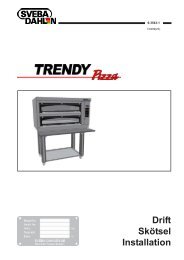

![PACOJET-DK[1]:Layout 1 - Bent Brandt WebShop](https://img.yumpu.com/18324212/1/184x260/pacojet-dk1layout-1-bent-brandt-webshop.jpg?quality=85)

